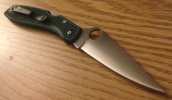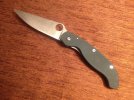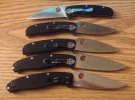I have some preliminary results. I tested my Para3 LW SPY-27 against a Benchmade Bugout in S30V and did two different tests, with one variable changed for each pair of tests.
Before testing, as previously mentioned, I did a heavy sharpening and removed any steel near the edge that theoretically may have been burnt or fatigued, as is common among production folders. The Bugout is easily on its 20th edge.
I used the Para3 to cut down a lot of cardboard boxes in preparation for the test. Anecdotally, SPY-27 seemed to outperform S30V. After stropping and using it more, I sharpened the knife again.
The cardboard is all brand new, 32lb edge crush rating, purchased from Home Depot in a pack of 25 large boxes. They've been in my basement for 2 weeks.
Because cardboard is corrugated, to cancel the variable of which direction it's being cut, I alternate directions every 30 or every 15 cuts, depending on if im getting close to the end of the test.
For the purpose of this test, I was making 9" cuts since the box started out with 18" dimensions.
There's no cutting board being used that's dulling the knife. I'm hanging each section over the end of a table, cutting strait down through the cardboard, with cardboard strips falling into a box underneath. From start to end of the cut, the knife is parallel with the ground and makes contact with nothing except for what's being cut.
Sharpening progression used: DMT DiaSharp 220, Atoma 400, Atoma 600
Strop: 10um 5 passes per side, 3um 5pps, 1um 10pps, and 0.25um 5pps.
With each, I verified the edge by first whittling a free hanging hair, then cut magazine paper in all directions.
After that, the blade gets taped off, exposing only a 1" section.
The stopping point to the test is when the knife no longer will easily slice copy paper in both directions. With a slow slice from end to end of the exposed edge, if it hangs up or fails to start, it's done. I check every 15 or 30 cuts. It should be able to make 5 consecutive cuts in a row without hanging up.
With a cardboard cut test, what's being tested isnt entirely Wear Resistance, which means results often do not directly correlate with CATRA tests. Clean cardboard is almost entirely cellulose, not sillica. Because the primary abradant (cellulose) is significantly softer than the test media (steel), what's being tested more than anything is the durability of the fine apex to the dynamic compressive forces that it endures while cutting cardboard.
For those reasons, the pressure and angle need to be controlled by the tester, which is relatively easy since we're testing a knife that's sharp from start to end of the test.
The angle of approach relative to the cardboard must be maintained. If you cut cardboard while holding the knife at 90° to the cardboard, its substantially more difficult to push cut than if you hold at about 45°. The harder you push the knife, the quicker it dulls.
So I did two pairs of tests, one at 90° to the cardboard and the other at 45°. Here are the results:
Holding at 90° to the cardboard
Benchmade Bugout S30V - 157.5 feet
Spyderco Para3 LW SPY-27 - 303 feet
Its important to note, this result does not mean SPY-27 has double the edge retention of S30V. It's also important to note that my S30V result is within the range typically found with other published cardboard cut tests. It also approximately matches the result I got with Spyderco S30V with a different brand cardboard of the same specifications.
Test #2
Holding at 45° to the cardboard
Benchmade Bugout S30V - 315 feet
Spyderco Para3 LW SPY-27 - 690 feet
This is a significant gain. I actually conducted the 45° degree tests before the 90° tests.
The reason the 45° test set is about double of what the 90° tests are because it takes about twice as much pressure to push cut at 90° versus 45°.
Cardboard has to spread out of the way of the blade. This is much more difficult if the cardboard has to spread from side to side, like it does when the knife is held at 90°. When the knife is held at 45°, one side of the cut bends in front of the blade and the other in back of it, which is much easier. Pressure matters.
Edit: I ran a 3rd knife on both angles. I tested a Civivi Shredder in D2 steel. This is a $60 knife with an inferior steel and a big geometry advantage. Its significantly thinner behind the edge. I need to just buy a caliper but the thickness difference is obvious since all of these have about a 16 degree per side edge.
When tested at both angles, the dynamics of the Civivi versus the other two give an interesting insight into the cardboard cut test itself.
With the Civivi Shredder being thinner behind the edge, and thinner overall, plus having a hollow grind, make it act much differently than the others with this test.
First I'll say the hollow grind makes the knife significantly more unstable during the cutting. I'm trying to stay focused on doing strait thin cuts and it wants to wobble alot when held at 90 degrees. The full flat grind of the Para3 and high flat grind of the Bugout make them much more stable.
When held at 45 degrees, the Shredder glides through like a dream. Being thinner behind the edge, and thinner overall, it produces less friction because the cardboard doesn't have to spread as wide as the blade passes through. This means less compressive forces at the apex which means better edge retention, at least for this test anyway.
Here's the results:
Civivi Shredder
Held at 90° to the cardboard it cut 117 feet
It should be expected that Civivi's D2 will fall below Benchmade's S30V. I suspect without the geometry advantage, the D2 would have quit sooner.
#2 Civivi Shredder
Held at 45° to the cardboard it cut 348 feet.
That beats the Bugout result at 45° which was 315 feet. Again the Para3 SPY-27 did 690 feet at 45°
For purposes of this test the Bugout and Para3 did not have a significant geometry advantage over one another. They both required similar pressure. The Civivi on the other hand was noticeably easier when held at 45 degrees.
My belief so far is that holding the knife at 90 degrees is a better test of the steel and holding it at 45 degrees is a better test of the knife overall. In the case of the Para3 SPY-27, it just plowed through with superior edge stability.
When holding at 90 degrees, the pressures of the cardboard against the whole blade seem to cancel out most of the geometry advantages regarding the thickness behind the edge. This would be true only up to a point, and then geometry will always win. Wear resistance and edge stability only go so far.
It would appear that the 45 degree angle allows geometry advantages of the blade to shine through more easily, which allowed D2 to beat S30V.
With all of this cutting, and a sore hand, I can say that the Spyderco Para3 LW definitely has an ergonomic advantage over the Benchmade Bugout.
Because SPY-27 is run a bit harder than S30V typically is, it will have better edge stability than S30V thus giving it better edge retention in many real world scenarios. The difference will be most noticeable by those who keep their knives very sharp.
We need more tests of SPY-27. My numbers are surprisingly high. I'll do some more when possible.



